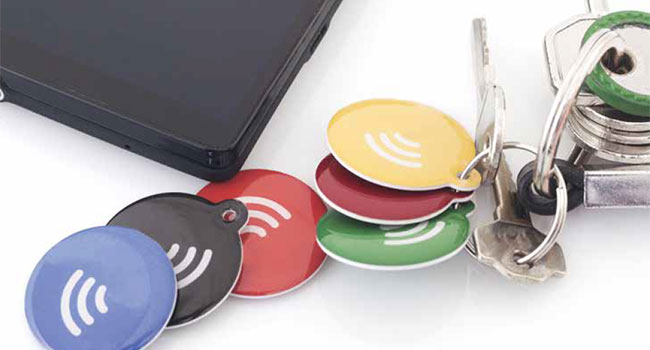
Automated Critical Security
Trusted ID solutions will make smart buildings safer
- By Mark Robinton
- May 01, 2018
Thousands of people pour into and out of high-rise office
buildings each day, and each must be kept safe and
secure. Two of the biggest challenges in accomplishing
this are guard tour management and ensuring that all
fire and safety equipment complies with inspection and
maintenance regulations. Trusted identities can be used to automate
and improve both processes.
Guard management is actually a three-part problem. Keys must
be tracked, guards must visit all their checkpoints as efficiently as
possible, and there must be a process for auditing billable contractor
hours. An identity solution that combines trusted near field communications
(NFC) tags and a cloud-based authentication system can
be used to automate each of these processes, integrating key management,
security patrol and contractor services into a single solution.
The resulting system enables secure proof-of-presence with frictionless
authentication while delivering more accurate and actionable
information in real time. It also can be deployed using an organization’s
existing IT infrastructure along with standard NFC-enabled
smartphones, tablets and other mobile devices.
To implement an automated key management solution, an organization
can use trusted NFC tags to provide unique identities to keys.
The way the system works is easy: To check out a physical key, a user
first taps a tablet or other mobile device with the trusted NFC tag
and enters an authorized identity. The user is then notified when the
key is due to be returned, and again taps the tablet to check it back
in. Automated key management significantly reduces the amount of
time and resources spent managing and replacing lost or stolen keys.
Organizations can account for each key in real time, and they have
access to historical issuance and return activities so they can better
understand which keys are in most demand.
Connected Guard Tour and
Contractor Management
To manage guard tours and patrols, various tag formats must be
placed at each patrol checkpoint throughout the building, and heavier-
duty tags can be used to designate outdoor checkpoints. From
there, guards simply tap each checkpoint visited with their NFCenabled
smartphone. The system identifies each checkpoint by name,
and automatically uploads timestamp information and updates databases
in real time, providing digital proof that a security patrol took
place at the proper location, and at the proper time. Alerts can be
triggered if too much time passes between checkpoints. If a guard
encounters an incident, the smartphone can be used to generate a
detailed report, including photo or video evidence, and to escalate
activity, when needed, according to protocol. A simple tap is the only
training needed to ensure effective system deployment.
Automated guard tour management makes it possible for guards
to deliver more timely and detailed reporting, while reducing how
long it takes for each individual security patrol. Facility managers
currently using these systems also note improvement in the management of their contract employee partners.
Using a similar “proof of presence” system for contractors has
resulted in more precise, auditable time and attendance, and ensures
facility managers are paying only for services rendered. Contractors
are ensured fair compensation for the work they have completed. Reports
detail all necessary information about site visits and activities,
providing management insight along with substantiation for contractor
invoices.
Streamlining Fire & Safety Inspection
and Maintenance
Similar efficiencies are realized when trusted tags and authentication
platforms are combined with Computerized Maintenance Management
Software (CMMS) to simplify fire/safety equipment inspections
and compliance. With these solutions, those tasked with equipment
maintenance and compliance can ensure that physical objects like
water valves and various sprinkler equipment can transact securely
to provide “proof of compliance” and “proof of presence.” This enables
field technicians to easily respond and record each inspection
digitally, in a secure and trusted cloud environment.
To use these systems, a technician simply taps his or her smartphone
or other NFC device to a tag that has been embedded or attached
to the piece of fire or safety equipment. Each tap provides
digital proof of each inspection report, and provides the technician
easy online access to service requests and automated maintenance
records. The same tap also verifies the identity of the field worker or
technician, and ensures that the person’s skillset or credentials align
with the qualifications needed to service specific equipment, and that
the correct field worker is servicing that piece of equipment.
There are numerous benefits with this type of system.
First, it automates the maintenance and inspection process, reduces
field inspection time, and accurately reports with proof of compliance,
resulting in a quantifiable cost savings from a reduction in labor
costs. Additionally, work orders are completed faster and there is an
overall reduction in the number of onsite visits. Both of these benefits
help increase overall cost savings. Tags can perform in a variety
of environments without compromising readability, and are flexible
enough to adhere to multiple types of surfaces, shapes and sizes, including
metal and rounded objects like alarm and control valves.
Demand is growing for cloud-based authentication platforms that
add trust to “proof of presence” applications to enhance building
safety and security. Facility managers can accurately track security
check points and instantly dispatch guards for instant response to
and reporting of fraudulent activities throughout the building. Security
guards can patrol areas more easily and efficiently with automated
patrol stops that replace manual sign-in processes.
Organizations can also tag fire and safety equipment to connect
it to the Internet, so that technicians can use their mobile devices to
tap the tag and access cloud-based CMMS applications, track activities,
and automate all of the previously manual processes involved
with making sure these assets are ready for an
emergency. From every guard checkpoint to every
piece of fire and safety equipment, trusted tags
and cloud authentication platforms help make
buildings both smarter and safer.
This article originally appeared in the May 2018 issue of Security Today.